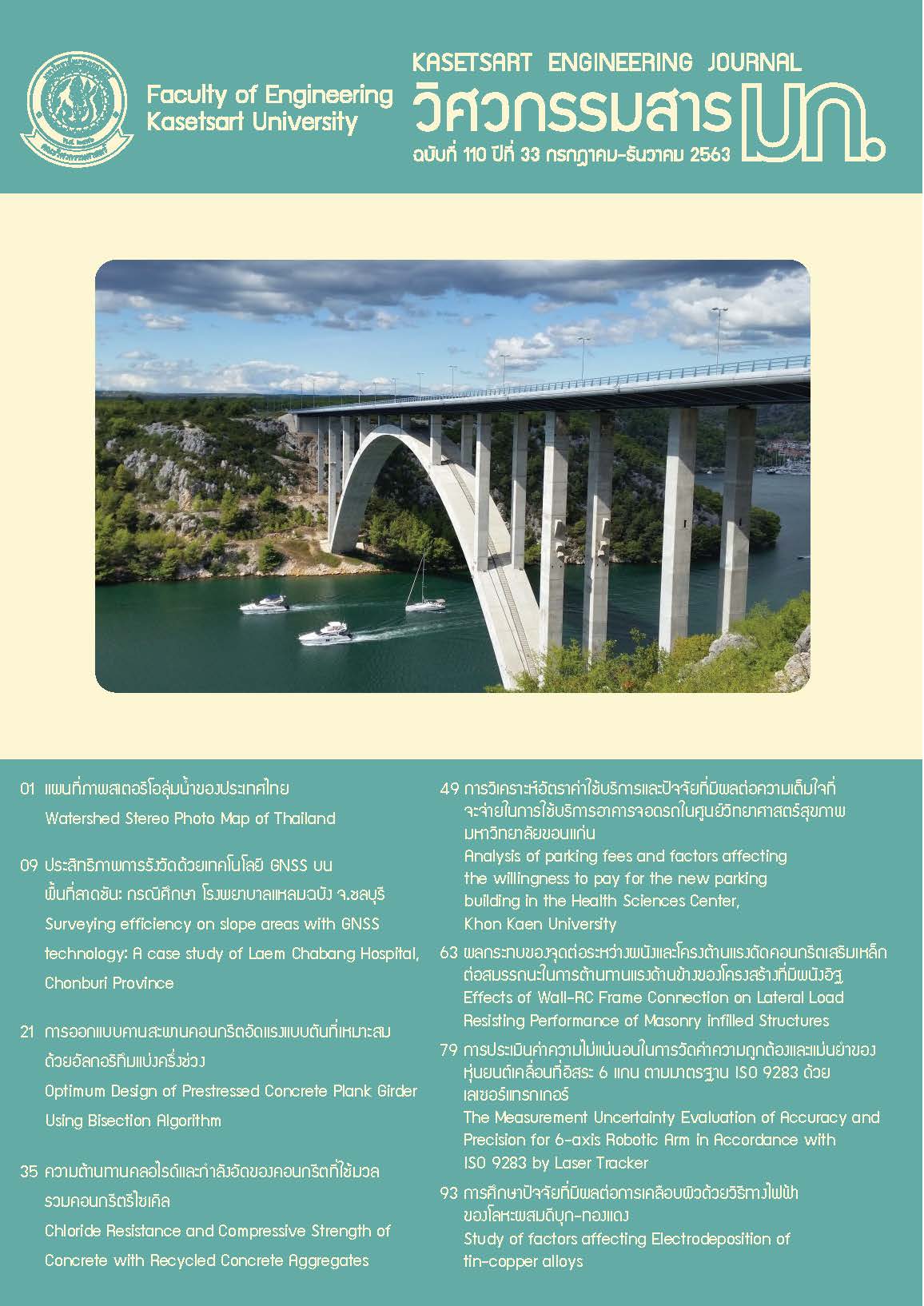Surveying efficiency on slope areas with GNSS technology: A case study of Laem Chabang Hospital, Chonburi Province
Keywords:
Surveying efficiency, Slope surveying, Static Surveying, Virtual Reference Station, Real-Time Kinematic, QGISAbstract
The aim of this research is to understand surveying efficiency on slope areas using Global Navigation Satellite System (GNSS). The root mean square error (RMSE) is used to be a key indicator to compare the efficiency of Virtual Reference Station (VRS) method and Real Time Kinematic (RTK) method using GNSS, Topcon brand and GR5 version. The surveys conducted on the slope areas where Laem Chabang Hospital, Chonburi Province located. The results of the study, when compared with the reference benchmarks, found that Real-Time Kinematic (RTK) measurement methods have an RMSE of 0.025 centimeters and the RMSE of Virtual Reference Station (VRS) techniques is 0.054 centimeters. We found that both of these methods have a difference RMSE of 0.033 meters. Therefore, we can conclude that Real-Time Kinematic (RTK) methods have less tolerance than the Virtual Reference Station (VRS) methods but are still acceptable. Considered that the coordinates obtained by surveying with satellite systems have the coordinates close to the reference benchmarks. The differences in both methods still have comparable values, which make those values reliable and able to apply both methods together. After that, we surveyed in the slope areas to perform topographic surveying and import to GIS (Geographic Information Systems). We used the Total Station equipment for positioning benchmarks to collect data and using GNSS satellite receivers to collect coordinates of the reference benchmarks using the static surveying method and collecting of other details that the Total Station may not reach with the Real-Time Kinematic Survey (RTK). Finally, after collecting all the data, we can then mapped using Quantum GIS with satellite imagery as a base map for highly detailed to be assembled for greater accuracy as well.
References
วิชัย เยี่ยงวีรชน (2548). การสำรวจรังวัด: ทฤษฎีและการประยุกต์ใช้. กรุงเทพมหานคร: สำนักพิมพ์แห่งจุฬาลงกรณ์มหาวิทยาลัย
สุทธิพล เอี่ยมประเสริฐกุล (2550). การหาค่าระดับเหนือระดับน้ำทะเลปานกลางของบ่อน้ำบาดาลด้วย GPS. หน้า 309 สืบค้นจาก http://library.dmr.go.th/Document/Proceedings-Yearbooks/M_1/2550/30576.pdf
KQ GNSS (2020). เทคนิคการรังวัดหาค่าพิกัดดาวเทียมด้วยระบบ GNSS. สืบค้นจาก
http://kqgnss.blogspot.com/2018/05/gnss.html 06 June 2020.
เจนพิธีกร สุนทรรัตน์ (2560). การทดสอบประสิทธิภาพระบบโครงข่ายดาวเทียมจีเอ็นเอสเอสแบบจลน์ในทันทีสำหรับงานรังวัดที่ดิน. วิทยานิพนธ์ปริญญาโท, จุฬาลงกรณ์มหาวิทยาลัย.
โชคชัย ตระกลกุล (2555). การประเมินความถูกต้องของค่าความสูงออร์โทเมตริกจากการสำรวจแบบเคลื่อนที่โดยใช้ระบบดาวเทียมนำหน. วิทยานิพนธ์ปริญญาโท, จุฬาลงกรณ์มหาวิทยาลัย.
สมเกียรติ ทิพย์สุมณฑา (2560). การประเมินประสิทธิภาพของเทคนิคการรังวัดดาวเทียมแบบจลน์โดยอาศัยเครือข่ายสถานี GNSS แบบต่าง ๆ ในประเทศไทย. วิทยานิพนธ์ปริญญาโท, จุฬาลงกรณ์มหาวิทยาลัย.
รุ่งโรจน์ เจริญยศ, ธีทัต เจริญกาลัญญูตา และ เฉลิมชนม์ สถิระพจน์ (2562). การประเมินผลความถูกต้องเชิงตำแหน่งทางราบของการรังวัดด้วยระบบโครงข่ายดาวเทียมจีเอ็นเอสเอสแบบจลน์ โดยใช้สถานีฐานอ้างอิงแบบรับสัญญาณต่อเนื่องถาวร สำหรับการรังวัดแปลงที่ดินในประเทศไทย. จุฬาลงกรณ์มหาวิทยาลัย.
นำพล ศักดิ์สนิท, ธีทัต เจริญกาลัญญูตา และเฉลิมชนม์ สถิระพจน์ (2562). การประเมินค่าความถูกต้องของค่าพิกัดทางราบด้วยค่าคลาดเคลื่อนรากที่สองกำลังสองเฉลี่ยที่เครื่องรับสัญญาณจีเอ็นเอสเอส อาศัยแนวคิดว่าด้วยสถานีอ้างอิงเสมือน ของโครงข่ายจีเอ็นเอสเอสแบบจลน์ เวลาจริงในประเทศไทย.วิทยานิพนธ์ปริญญาโท, จุฬาลงกรณ์มหาวิทยาลัย.
นิทัศพงษ์ นิวาศานนท์, ทยาทิพย์ ทองตัน และเฉลิมชนม์ สถิระพจน์ (2562). การประเมินประสิทธิภาพของการรังวัดดาวเทียมจากโครงข่ายแบบจลน์ในทันทีในประเทศไทย: กรณีศึกษาการกระจายตัวของจุดทดสอบ.วิทยานิพนธ์ปริญญาโท, จุฬาลงกรณ์มหาวิทยาลัย.
Michael P, Sama (2020). Performance Evaluation of a Tracking Total Station as a Position Reference for Dynamic GNSS Accuracy Testing. Available via: https://uknowledge.uky.edu/cgi/viewcontent.cgi?referer=https://scholar.google.com/&httpsrdir=1&article=1006&context=bae_facpub 06 June 2020.


